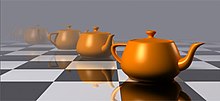Distance fog
Distance fog is a technique used in 3D computer graphics to improve the perception of distance by shading distant objects differently to simulate aerial perspective .
description
Because some of the shapes in graphical environments are relatively simple and complex shadows are difficult to render , many graphics engines use a " fog " gradient so that objects farther away from the camera are increasingly obscured by haze and aerial perspective. This technique simulates the effect of light scattering , which causes objects further away to appear less contrasted, especially in outdoor environments.
The visibility with natural haze decreases exponentially, not linearly, with distance due to the scattering. The color of the light scattered into the viewing path affects the color of the haze; blue under a blue sky, reddish at sunset, like the alpenglow. These more subtle details are shown in some graphics.
Fogging
Fogging is another use of distance fog in games in the mid to late 1990s, when the computing power was insufficient to render long viewing distances and cropping was introduced. Trimming could be very disruptive as parts of polygons would fade in and out instantly, and by applying a mid-range fog, the trimmed polygons would appear at a sufficiently great distance that they were obscured by the fog and when approaching the Player. The effect was widespread, with Turok: Dinosaur Hunter , Bubsy 3D , Star Wars: Rogue Squadron , Spider-Man , GoldenEye 007 , Tony Hawk's Pro Skater, and Superman 64 being just some of the games that used this effect. Silent Hill has worked into the plot of the game in a unique way, with the city of the same name being covered by a thick layer of fog as the player has entered an alternate reality. The use of fog as an atmospheric technique has been so well received that it shows up in every episode of the game, though improved technology negates it as a graphical necessity.
See also
Individual evidence
- ^ The Next Generation 1996 Lexicon A to Z: Depth Shading . In: Imagine Media (ed.): Next Generation . No. 15, March 1996, p. 32.
- ↑ Elena Deza, Michel Deza: Encyclopedia of Distances . Springer-Verlag, 2009, p. 513. Archived from the original on February 23, 2012 (accessed September 25, 2011).

